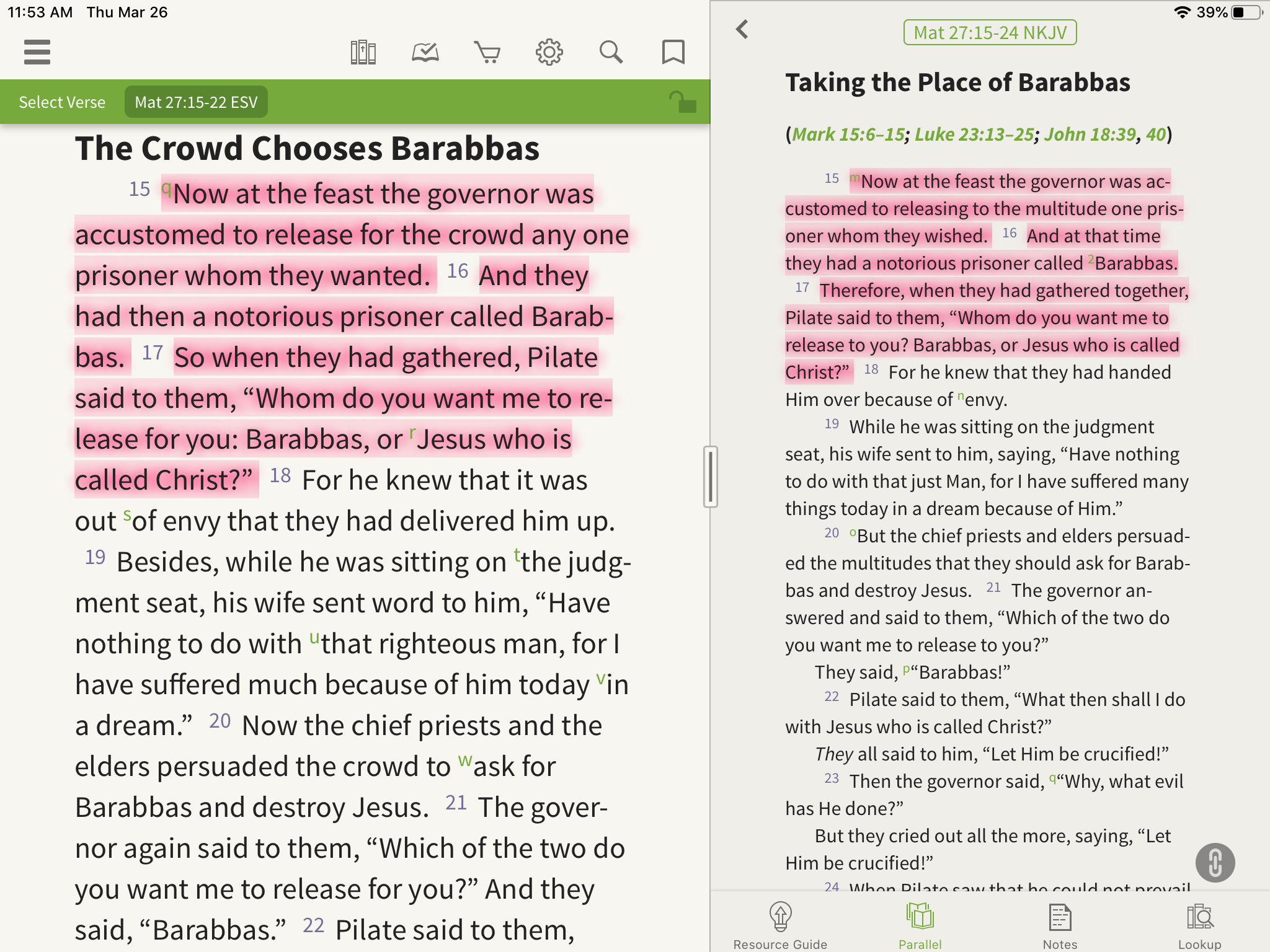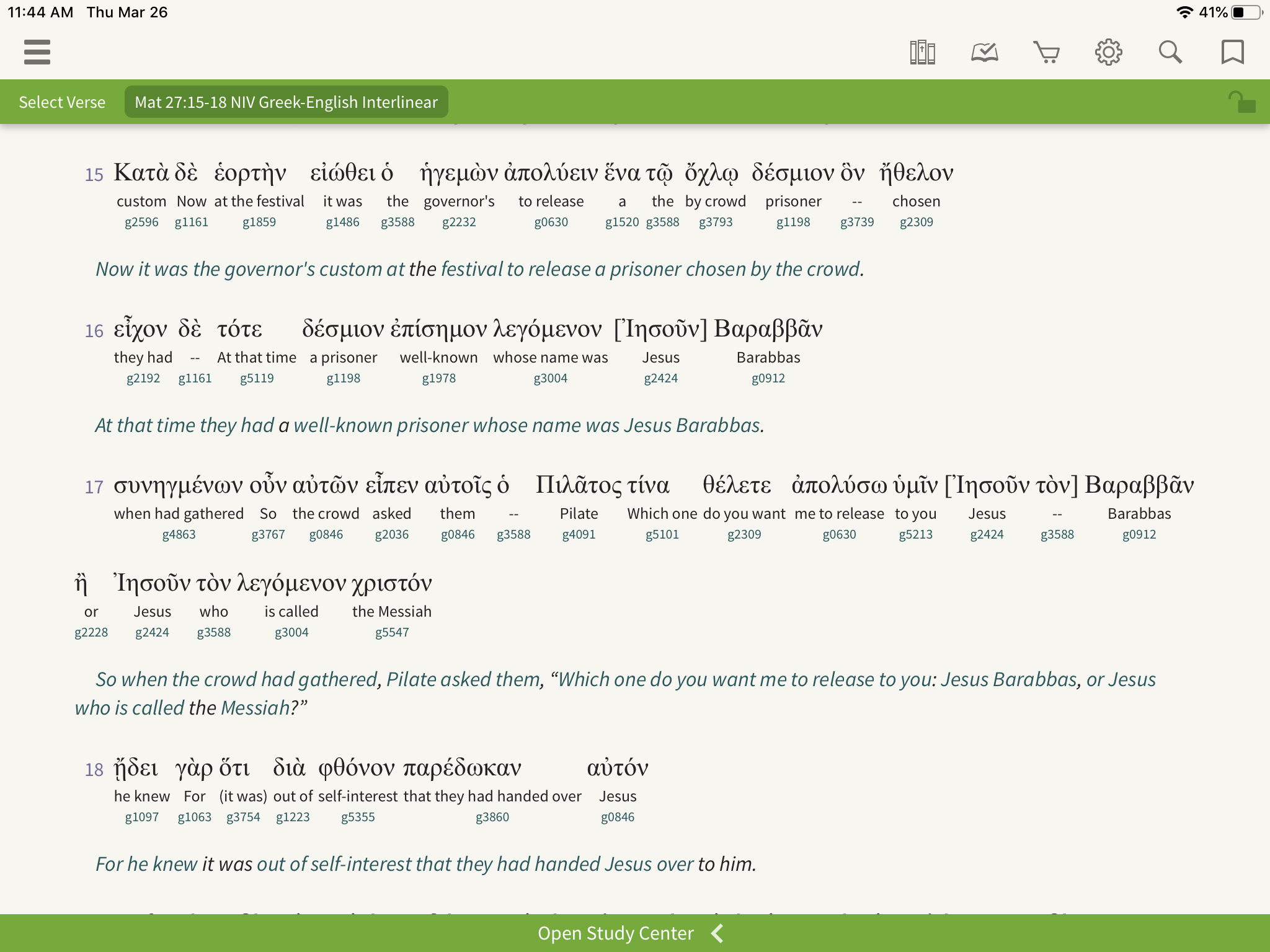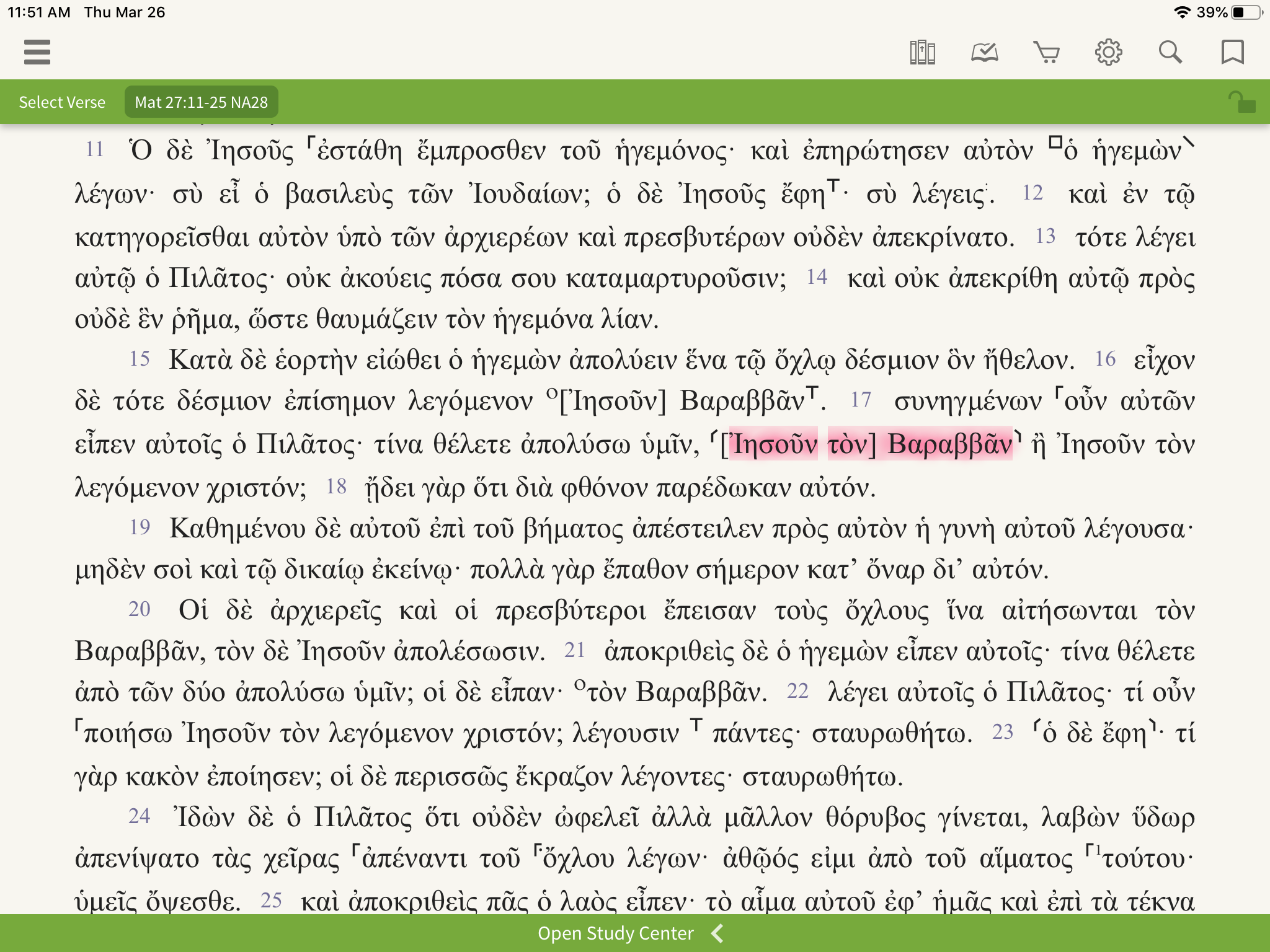We’ve all experienced an eye-opening moment while reading the Bible. You’re skimming over a familiar passage and WHAM! What’s this? Something new!? It’s wild how this still happens with a book that is thousands of years old. And yet, you can probably find something fresh in these two short verses referencing Barabbas:
Now it was the governor’s custom at the festival to release a prisoner chosen by the crowd. At that time they had a well-known prisoner whose name was Jesus Barabbas. So when the crowd had gathered, Pilate asked them, “Which one do you want me to release to you: Jesus Barabbas, or Jesus who is called the Messiah?”
— Matthew 27:15-17 (NIV)
The question Pilate poses is an interesting one: “Which Jesus do you want?” At least, that’s how the NIV renders it. If you’ve never realized that Barabbas is actually a second name, that’s ok. You aren’t alone. Other translations only call him Barabbas.

Other Translations of Matthew 27:15-17
ESV: So when they had gathered, Pilate said to them, “Whom do you want me to release for you: Barabbas, or Jesus who is called Christ?”
KJV: Therefore when they were gathered together, Pilate said unto them, Whom will ye that I release unto you? Barabbas, or Jesus which is called Christ?
NASB: So when the people gathered together, Pilate said to them, “Whom do you want me to release for you? Barabbas, or Jesus who is called Christ?”
But look! NET Bible says “Jesus Barabbas” as well.
NET Bible: So after they had assembled, Pilate said to them, “Whom do you want me to release for you, Jesus Barabbas or Jesus who is called the Christ?”
Here are the questions we hope to answer:
- Why are there differences in the text?
- Who was Jesus Barabbas?
- What can I learn from this?
Digging Deeper with Greek: Jesus Barabbas?
This difference in translations is called a “textual variant.” Understanding why a translation committee chose a specific set of words can lead you on a treasure hunt. The process can be exciting, but the end result can be either enlightening or plain obvious. You never know what you’ll find, but let’s try!
Barabbas in the NIV Interlinear
One way of finding out more information is by opening an interlinear. Here we can see the NIV translation and the Greek text they worked with. Here’s what we found:


In verses 16 and 17 you can see [Ἰησοῦν (τὸν)], the standard name Jesus or Joshua at the time. Notice where our main man Jesus is mentioned. His name isn’t in brackets. So, now we at least know the NIV translations didn’t make this up. Of course, translators would never do such a thing. But it is relieving to see a textual variant called out in the Greek like this.
Barabbas in the NA28
Let’s also check out the NA28 for fun. The brackets should still surround his first name.

Yep! There it is! But surely the Greeks didn’t use brackets, right? Why are they there? Looking at a couple other resources may provide more insight.
Digging Deeper with Study Resources: Jesus Barabbas?
We looked into two rather technical resources for information. Of course, when you’re studying textual variants, what isn’t going to be highly technical? First, we’ll share a quote from Bruce Metzger’s A Textual Commentary on the Greek New Testament. Then, we’ll see what the NET Bible has to say.
Barabbas and Bruce Metzger
If you’ve never heard of Bruce Metzger’s commentary, you’ll want a fair warning before diving into his writing. His work is used as a companion to the United Bible Societies’ Greek New Testament Fourth Edition (UBS4). That’s a big deal! Also, it guarantees that we are about to read some heavy academia. Try this out:
An Excerpt
Matthew 27:16 [Ἰησοῦν] Βαραββᾶν {C}
The letter {C} indicates that the Committee had difficulty in deciding which variant to place in the text.
“A majority of the Committee was of the opinion that the original text of Matthew had the double name in both verses and that Ἰησοῦν was deliberately suppressed in most witnesses for reverential considerations. In view of the relatively slender external support for Ἰησοῦν, however, it was deemed fitting to enclose the word within square brackets.”
Still with us? Here’s a summary (our own version), in case you didn’t catch it.
The UBS-4 committee wasn’t sure whether the text should be “Jesus Barabbas” or “Barabbas” in Greek. After researching, they determined “Jesus Barabbas” was in fact Barabbas’ name. However, more versions of this account exclude “Jesus” than include it. The committee thinks this is out of respect to Jesus the Messiah. So, in the end, they left it “Jesus Barabbas” but included the brackets to tone it down.
Barabbas and the NET Bible
Lastly, let’s look at the NET Bible. If you’ve never heard of the NET Bible, it is a fascinating tool for textual-variant fanatics. The Bible contains more than 60,000 notes, highlighting every major decision, outlining alternative views, and explaining difficult or nontraditional renderings. Then, NET Bible users shared their considerations online. The translation committee read through the comments and concerns, about put out a second edition. Essentially, this Bible is a team effort!
So, we already know the NET Bible includes “Jesus” as Barabbas’ first name. We shared that information toward the beginning of this post. But maybe there is a note that will shed light on why they made this decision, similar to the NIV translation.
An Excerpt
Although the external evidence for the inclusion of “Jesus” before “Barabbas” (in vv. 16 and 17) is rather sparse, being restricted virtually to MSS of what was formally labeled the “Caesarean” text (Θ ƒ1 700* sys arm geo2; Ormss), the omission of the Lord’s name in apposition to “Barabbas” is such a strongly motivated reading that it can hardly be original.
There is no good explanation for a scribe unintentionally adding ᾿Ιησοῦν (Iēsoun) before Βαραββᾶν (Barabban), especially since Barabbas is mentioned first in each verse (thus dittography is ruled out).
Further, the addition of τὸν λεγόμενον Χριστόν (ton legomenon Christon, “who is called Christ”) to ᾿Ιησοῦν in v. 17 makes better sense if Barabbas is also called “Jesus” (otherwise, a mere “Jesus” would have been a sufficient appellation to distinguish the two).
We’ll summarize this for you, too:
Basically, the stronger reading omits “Jesus”; however, there is no reason for a scribe to have incorrectly added that name if it did not belong to Barabbas. Also, why would the author then specifically point out that the second person is Jesus, the Messiah? It makes sense that the additional context was added because both men are named Jesus.
Digging Deeper with Context: Who was Jesus Barabbas?
Now we know that “Jesus” really is Barabbas’ name. It isn’t a mistake, even though many other translations don’t include it. Also, it isn’t some kind of secret message. It really is just a name. But we can take this one step further and learn more about who Barabbas was.
Gospel harmonies are a super easy way to evaluate all the information we have on a single event during Jesus’ life. Also, if you use the NIV Word Study Bible version of our harmonies, then you can get original language information quickly, too. Let’s use this to see what each gospel account says about Barabbas.

References to Barabbas
A man called Barabbas was in prison with the insurrectionists who had committed murder in the uprising. — Mark 15:7
(Barabbas had been thrown into prison for an insurrection in the city, and for murder.) — Luke 23:19
They shouted back, “No, not him! Give us Barabbas!” Now Barabbas had taken part in an uprising. — John 18:40
Then, tapping on “Barabbas” can show us if there is anything else we should know. His name means “son of a father or master.”

So What?
There isn’t always some grandiose meaning hidden inside the Greek. But we can create metaphors and meaning from what we read that spurs us in the direction of Christ. That’s part of Scripture being alive. With that in mind, let’s first re-cap what we’ve learned.
What We Learned
- The NIV and NET calls Barabbas “Jesus Barabbas.”
- The Greek confirms that Barabbas’ first name is Jesus
- “Jesus” means “Jehovah is salvation”
- “Barabbas” means “son of a father or master”
- “Messiah” means “son of God”
What It Could Mean for Us
Without knowing that Barabbas’ first name is Jesus, we can already see the moral of this story. The crowd chooses to release a man incarcerated for murder, instead of God-incarnate. They didn’t choose Jesus. But when we take their names into account, the problem becomes even clearer.
Quite literally, Pilate asks the crowd if they want Jesus, the son of a father, or Jesus, the son of the Father.
This is the kind of stuff that sticks in people’s minds. If you’re teaching a Bible study or preaching a sermon, you can guarantee people will remember this question: “Which Jesus do you want?”
This wouldn’t be the first time people chose the wrong Jesus. Throughout history, Christians have made Jesus into who they want him to be. We often choose a Jesus that looks a bit more like us: physically, politically, ideologically. The crowd that day did the same, and wound up murdering the person who loves them the most.
Here are some real ways to implement this concept:
- Read the Gospels (maybe with a reading plan or a gospel harmony) and take note of Jesus’ traits — as many as possible.
- When you face a difficult situation ask yourself, “Which Jesus do I want?” We’ve been taught to ask “What would Jesus do?” but that question doesn’t help us if we are looking to the wrong Jesus. Remind yourself of the traits you wrote down earlier.
- Meditate on these traits. Take some time to visualize Jesus the Messiah. This doesn’t necessarily mean that you try to picture Jesus’ face and clothing. Maybe you let these traits remind you of ways you have seen others live them out. We are all, in fact, made in the image of God. We are His hands and feet.
Thanks for studying along with us! We hope this article not only taught you some helpful study tips, but also brought you one step closer to Jesus the Messiah.




0 Comments